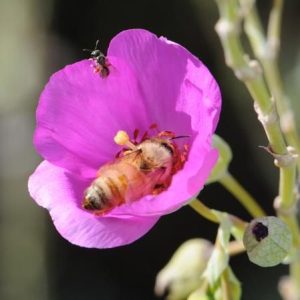Who doesn’t jump on the bandwagon for a cause that is held close to one’s heart? On any given moment on the internet, on the TV, on the radio, and at the water cooler people will rattle their swords for a cause. How about a cause that is easy to assist, won’t create any upheaval, and makes you happy, all at the same time? How about a cause that will keep us all alive?
Slip back into your high school biology class. The girls blushed and the boys snickered, at least during my time, when the teacher started talking about pollination. The next generation of seeds, fruits, and plants starts when the pollen grain moves from the male part (the anther) of the flower to the stigma (the female part).
Pollinators move from plant to plant with pollen attached to their bodies, distributing genetic materials to flowering plants and creating new life. Flowering plants are important for many reasons: flowering plants give the world vegetables, fruits, and nuts, half of the world’s oils, raw materials and fibers, help prevent erosion, and assist in carbon capture and long term storage. The bottom line is one out of every three bites of food you eat comes from the work of pollinators.
Pollination occurs with many of Mother Nature’s children. About 80% of pollination is achieved with animals and insects. The other 20% is completed with wind and in a small part, water. So who are the pollinators? Birds, bats, butterflies, beetles, wasps, small mammals, bees, moths, flies, and hummingbirds all assist in pollination.
All of those pollinators are affected by variables such as destroyed habitats, pesticides, non-native pollinators outpacing native pollinators, pollution, diseases, and changes in climatic patterns. The variables are overwhelming. Over 200 species of pollinators are considered endangered, threatened, or extinct.
The problems are evident. Now how about helping the cause? Pollinators are just like us: they need water, food, and shelter. Like us, they have preferences for their living arrangements. First, we need to plant desirable vegetation. Timing the flowering schedule for blooms a majority of the year provides consistent food. Many pollinators have preferences on planted areas; cover the basics by providing areas of sun, partial shade, and full shade. By planting dense shrubs and trees, your pollinators will be sheltered from the wind and elements. Flowers should be planted in a grouping, not singularly. Groupings will attract more pollinators to your yard. Use perennials over annuals, perennials are richer in nectar and are a more dependable source of food. Plants that produce double or high pedal count flowers are not as desirable, such as marigolds and English roses. These flowers have been bred for how they look, not for their pollen or nectar. Colors and flower shapes are important to provide for the most variety of pollinators.
Clean water and a damp salt lick will be a choice stopping point. Water in a shallow dish or birdbath with resting spots made out of protruding stones will be perfect. Butterflies and bees like a moistened salt lick. Mixing a small amount of sea salt or wood ashes into a dampened spot will add minerals to their diets.
Pesticides must be used sparingly if at all. Herbicides and insecticides do not discriminate; they eliminate good and bad species alike. Even following label instructions can affect the pollinators in your yard. By using other means than chemicals your yard’s ecosystem will be healthier for everyone enjoying the landscape.
Pollinator Protectors are the crusaders of the pollinator world. Habitat area counts and Pollinator Protectors build landscape to help sustain pollinators and our food supply. All of our futures fly on the wings of pollinators and the good hearts of Pollinator Protectors. This is a good cause to join!
Julie Silva is a University of California Cooperative Extension Master Gardener of Tuolumne County.
UCCE Master Gardeners of Tuolumne and Calaveras Counties can answer home gardening questions. Call 209-533-5912 or to fill out our easy-to-use problem questionnaire here. Check out our website here, You can also find us on Facebook.

